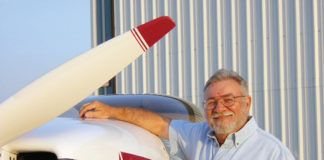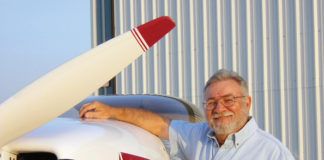Scary! Taking that first cut into the sheet metal of the panel can be tougher than getting a straight answer from a politician. There was a calming effect when you discovered hole saws, panel punches and trepanning tools, but what do you do about that square or rectangular hole? It could be cut with a punch…if you happen to have that exact size and a huge press. The metal is too thick for a nibbler, which leaves a saw. But is that the only option?
Actually, no. This is “The Home Machinist,” so it would seem reasonable that wed walk over to the milling machine. But wait a minute. The panel is a bit too large to fit on the table. We could cut one hole, then shift the material and realign it, but that seems a bit too laborious, and it would still leave a large radius in the corners that would have to be filed away. There must be an easy way!
Getting Square
When I made my last panel I had access to a water-jet cutting machine. I designed the entire panel on a $5000 software program and then took a CD to the shop that did work for the company I worked for. A quarter of a million dollars creates 80,000 psi, pushing a jet of water and abrasive particles that slices through aluminum with zero warpage and only 0.020 inch of material lost due to the kerf, i.e., the width of the jet. When that was no longer an option, it became necessary to find a technique that gave a good result using only what I could reasonably find, beg, buy or borrow for home use.
How about instead of using a mill we try that inexpensive wood router? Or lets give it a shot with a $25 air cut-off tool. Then there’s the crude old jigsaw, but thats not going to work well. Or will it?
The problem involves more than just cutting a rectangular hole; it has to be very accurate. I recently received the housing for a new EFIS panel and was challenged by the lack of overhang on the top and bottom of the bezel-a mere 0.040 inch of a lip is not much. If this is going to look nice, the vertical dimension has to be within 0.020 inch if its going to fit and not show gaps. There was plenty of overhang on the sides, but the bottom overlap looked just like the top, a very thin margin of error.
While Im on the subject, I need to vent a bit regarding instrument panel components: The three characteristics basic to long-term customer satisfaction are form, fit and function. Function is now 99% software based and will be changed, debugged, revised or upgraded before you even get the equipment installed, so what you see is not what you get, or what you will have next year. Can you spell iPhone?
Form is up to you and the stylist. It does seem humorous, though, that Henry Fords Model T and this latest bleeding-edge technology are both available only in black.
Fit, however, is ignored until you’re staring at the panel and sensing the clouds of incipient disaster. The sun comes out when the powers turned on, but it would be nice to have at least 1/8 inch top and bottom.
Hopefully, the openings for the radio, transponder and engine display will be no more difficult, so if I can solve this problem, those will be easy. They couldn’t be worse…could they? The first thing to do was to test the tools and techniques available. So I scribed a line on a sheet of 0.090-inch-thick aluminum, and I did my best to follow it.
Trying Out the Bandsaw
The bandsaw was first. A bandsaw can be used to cut a square hole if you first drill a hole in the area of the scrap, then cut the blade, push one end through the drilled hole, weld the blade back together, make the cut, break the blade and you have your part. Not much fun and definitely not the best scenario, especially when you don’t have a blade welder. But for comparison of surface finish and straightness of the cut, I thought Id give it a try with just an ordinary dont-break-the-blade cut.
Then Comes the Jigsaw
The most common attack to the problem is the jigsaw. It has the disadvantage, though, of not being as controllable as the bandsaw. Like the bandsaw, you start by drilling a hole…no, make that two holes in the area that will drop out. Don’t try to make the holes tangent to the lines. Doing so creates two problems: One, the width of the blade means you wont be able to start the cut on the line, so all you’ve done is risk going over the line when you drill the hole. Two, you’ll still have a little nub of material that will have be filed off.
Placing the two holes in opposite corners allowed me to cut the two sides closest to each hole, then, after the majority of the material was out of the way, turn around and cut back toward the corners where the holes were drilled. However, its tough to get the cut to restart at that shallow angle, so resign yourself to a lot of file work. Not fun.
Someone out there is about to write, advising me to drill small holes in each corner as a starting point for the saw. While its a nice idea, especially as a way of avoiding stress concentrations and subsequent cracks, a hole large enough for the saw blade is not practical with the way-too-small flange on the top and bottom of the screen; it would show.
Next, the Router
The next tool was the router. This sounds really weird! A wood tool used to cut metal? Yes, and it will work fine under the right conditions. The trick is to support the material on a sheet of plywood, and then place a fence or guide on top to keep the tool going in a straight line. I set this up with -inch-thick plywood held with wood screws so as to both clamp the aluminum and act as a fence.
Setting up the router proved to be straightforward. The base is exactly 6 inches in diameter and the cutting tool is 0.250 inch. If I cut to the inside of the line and have the router moving outside the cutting zone, I have to position the fence 3 inches minus 0.125 inch from the line. Its a simple thing to check by just putting the router in place with the power off.
Next, the bit has to be extended so that it cuts through the depth of the aluminum. Thats the reason for that flat scrap of wood under the part. (You could leave this out if you don’t mind your workbench looking like the tunnels in that ant farm you had as a kid.) High hopes were dashed, however, when the cut wandered. There’s a tendency for the entire tool to go away from, or into the fence, because of the nature of the rotating cutter. But thats why the fence is there, so why did it not cut right on the line?
Some experimentation revealed that the bit itself was bending. This was a wonderfully successful technique with the thin aluminum on the back deck of my RV-6, so it must be that it is limited to material less than 1/16 inch thick. Look closely at the photo of the cut made by the router, and you’ll see that one end moves away from the black line. The surface finish was not nearly what I expected either. It was acceptable, but not great.
Although the router was disappointing for finish work, it was useful in cutting the panel out of 4×4-foot sheet, which just was not going to go through my bandsaw. The jigsaw would have worked, but it was fun to see my neighbors face when the chips started to fly.
Finally, I used a thin abrasive wheel on a 20,000-rpm pneumatic motor. Ear and eye protection are vital here. Even a particulate breathing mask might be a good idea, because this put out a lot of aluminum powder.
Start about a half-inch from one corner and then descend into the material while moving toward the next corner. This lateral motion keeps the cut from occurring over too much of the circumference of the blade and bogging down. After the blade breaks through in about 1 inch of travel, reverse direction back to the starting corner. The blade is circular and the axis of rotation is above the material, so its not cutting straight down. That means you’ll have to stop short of the ultimate end point, leaving a tiny tab. Reverse direction again, going back the way you started, and continue to the next edge.
Now, repeat this for all four sides. The center wont have fallen out, though, because you’ve left a tiny tab in each corner. You might be tempted to turn the material over and cut from the other side, but a pneumatic jigsaw will finish that last 1/16 inch, and a quick touch-up with a file gives a straight, smooth edge with absolutely square corners.
Those corners, though, are too square. Cracks start at corners like that, so eliminate the inherent stress concentration by using a very small round file to give the corner a radius.
This worked well. Loud, yes, but the surface finish was great, and keeping it on the line was easy.
Making the Cut
What about the results? The jigsaw and the bandsaw gave a predictable finish thats largely a function of the quality of the blade. Is it new? Are you using a metal-cutting blade of at least 18 teeth per inch? If not, you’re only making the job more difficult.
The width of the blade can help. By width, I mean the distance from the point of the teeth to the opposite edge. The larger the width, the straighter the cut.
While were taking a look at the blade, notice that there are alternating teeth offset left and right. The blade may be made of material only 0.020 inch thick, but if the teeth are offset 0.005 inch, the result is that 0.030 inch of the material winds up on the floor as micro-chips. The remaining groove is due to a feature of blade technology called “kerf,” and it can vary from blade to blade. Its purpose is simple: Without it, the blade would tend to bind in the groove.
The bandsaw had the same finish, and, with care, roughly equal straightness as the jigsaw. But that need to break and weld a blade makes this a no-go right from the get-go.
The surprise was the cut-off tool with the 3-inch abrasive wheel. It was easy to stay on the line, and its large diameter meant that it wouldn’t easily wander. Youd better start straight, though, because you wont make a correction easily. Conversely, don’t try to change direction while deep into the material; you’ll break the wheel, and at 20,000 rpm the pieces are dangerous. Ill repeat that: Dont ever use the side of the wheel as a cutting surface. It is fiberglass and as you cut the material, you are cutting the wheel and breaking the glass fibers. The result is that you’ve broken the fibers that hold the perimeter of the wheel, and the resulting shrapnel is dangerous.
The upside is that it gave a superb finish, and only required a tiny bit of saw and file work in the corners with a quick wipe of a Scotch-Brite pad to soften the sharp edges.
As you can see from the photo, I got a superb fit that needed only a tiny bit of filing. Inasmuch as this was a new technique, I cut a bit undersize and with that miniscule flange there’s not much room for error.
When I cut the openings for the radio and the transponder, Ill be a bit braver and go right up to the line. (Breathe deep, push, chant your mantra…)
A neighbor suggested a plasma cutter. Ive used them and they are great for this sort of thing. Maybe for my next birthday, but $1000+ is a bit beyond the budget right now, and the cutting wheel works fine. When I get a plasma cutter, Ill show you how it works, but for the time being thats not in the cards.
An Ounce of Prevention…
This would all go away if the manufacturers of the components would either give us a tiny bit more flange and/or have their tool-and-die makers come up with a punch/system specific to their product. You would buy the component and add on a deposit for the tool. When the tool is returned to the component maker, youd get some portion of the deposit back. How about it, manufacturers?
Next month well look at a computer program that will allow you to make a 3D drawing of each of the items for your panel, and then arrange them into the perfect layout. From that you’ll be able to make a precise drawing of the finished panel, and the software is free!
Editors note: If you have specific questions for author Bob Fritz, or if you have certain projects youd like us to cover, email us at [email protected] with “Home Machinist” in the subject line.













